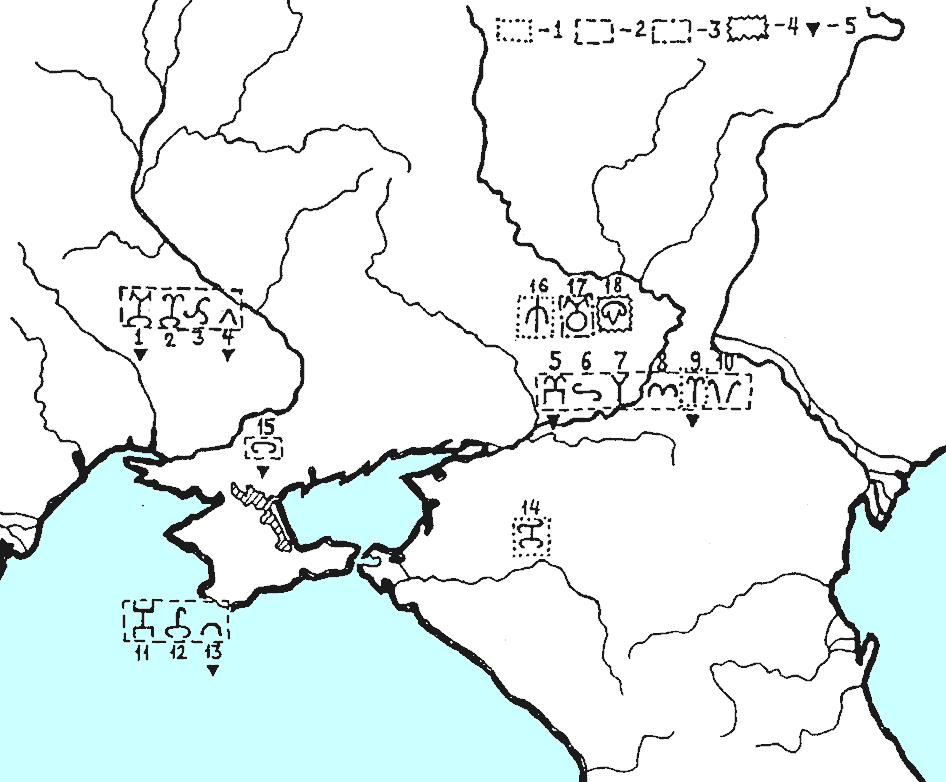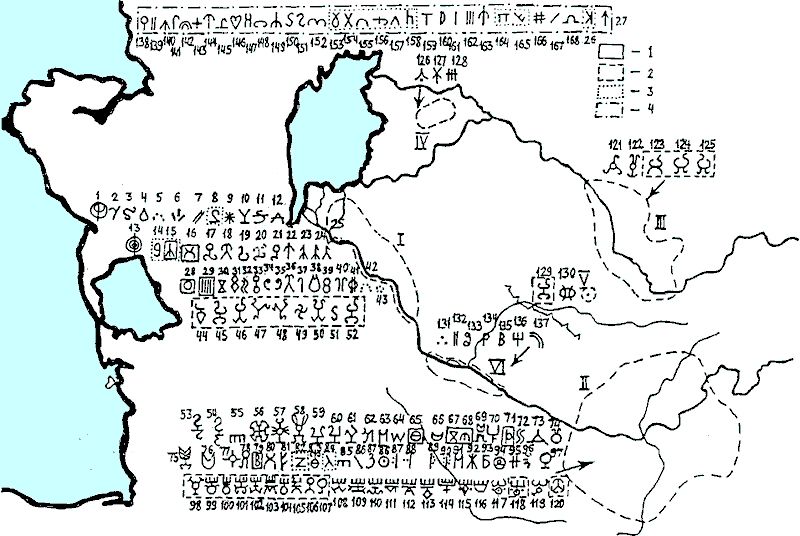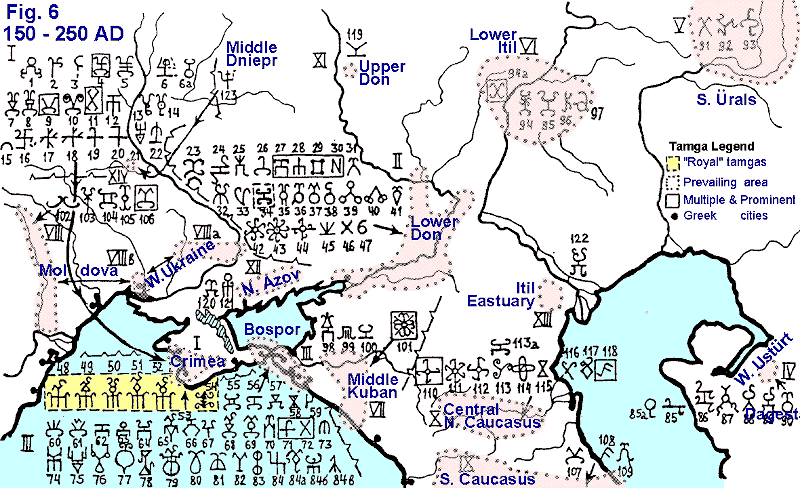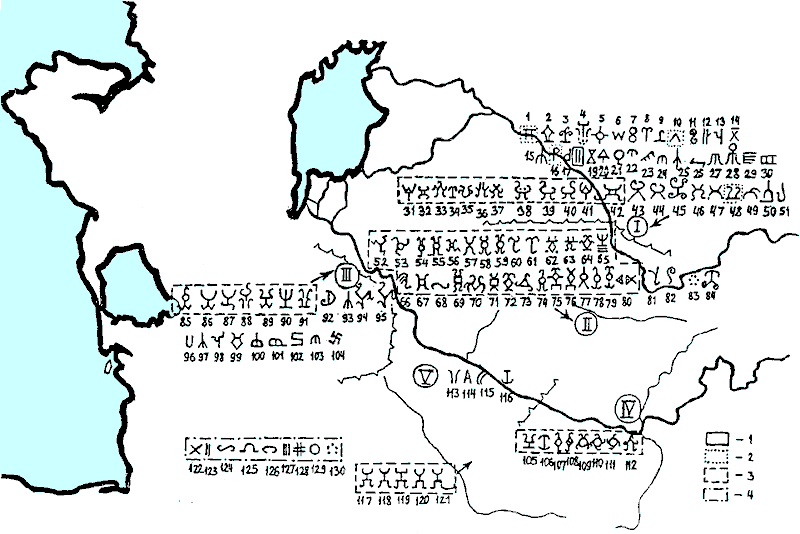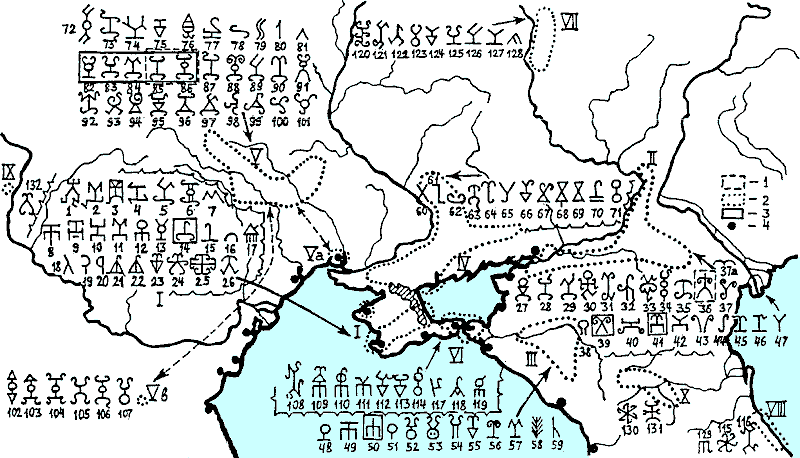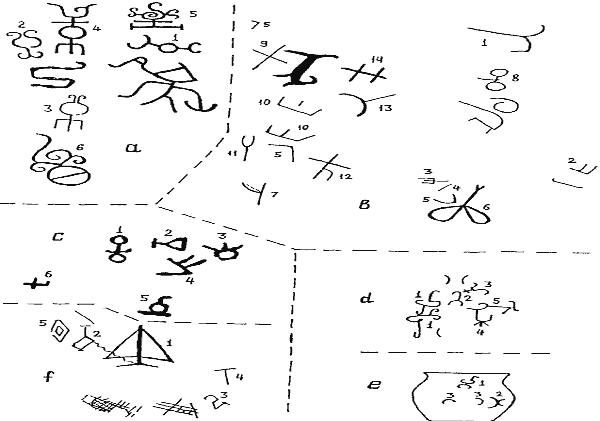|
Home Back In Russian Tamgas Contents Codex of Inscriptions Index |
Sources Roots Alphabet Writing Language Religion |
Genetics Geography Archeology Coins Wikipedia |
Ogur and Oguz Alans and Ases Overview of Sarmatian chronology |
Saltovo-Mayak Culture Codex of Inscriptions-Euro Asiatic-Don Alanian Etymology Notes Alans in Pyrenees |
Alan Dateline Avar Dateline Besenyo Dateline Bulgar Dateline Huns Dateline Karluk Dateline |
Khazar Dateline Kimak Dateline Kipchak Dateline Kyrgyz Dateline Sabir Dateline Seyanto Dateline |
||||||||||||||||||||||||||||||||||||||||||||||||||||||||||||||||||||||||||||||||||||||||||||||||||||||||||||||||||||||||||||||||||||||||||||||||||||||||||||||||||||||||||||||||||||||||||||||||||||||||||||||||||||||||||||||||||||||||||||||||||||||||||||||||||||||||||||||||||||||||||||||||||||||||||||||||||||||||||||||||||||||||||||||||||||||||||||||||||||||||||||||||||||||||||||||||||||||||||||||||||||||||||||||||||||||
|
S.A.YATSENKO Chapter 6 | ||||||||||||||||||||||||||||||||||||||||||||||||||||||||||||||||||||||||||||||||||||||||||||||||||||||||||||||||||||||||||||||||||||||||||||||||||||||||||||||||||||||||||||||||||||||||||||||||||||||||||||||||||||||||||||||||||||||||||||||||||||||||||||||||||||||||||||||||||||||||||||||||||||||||||||||||||||||||||||||||||||||||||||||||||||||||||||||||||||||||||||||||||||||||||||||||||||||||||||||||||||||||||||||||||||||||||||
| Table Of Contents | Section 7 - Middle Asia => | Section 11 - Tamgas Of Middle Ages Alans => | Section - Literature and Sources => | |||||||||||||||||||||||||||||||||||||||||||||||||||||||||||||||||||||||||||||||||||||||||||||||||||||||||||||||||||||||||||||||||||||||||||||||||||||||||||||||||||||||||||||||||||||||||||||||||||||||||||||||||||||||||||||||||||||||||||||||||||||||||||||||||||||||||||||||||||||||||||||||||||||||||||||||||||||||||||||||||||||||||||||||||||||||||||||||||||||||||||||||||||||||||||||||||||||||||||||||||||||||||||||||||||||||||
Selected Quotation | ||||||||||||||||||||||||||||||||||||||||||||||||||||||||||||||||||||||||||||||||||||||||||||||||||||||||||||||||||||||||||||||||||||||||||||||||||||||||||||||||||||||||||||||||||||||||||||||||||||||||||||||||||||||||||||||||||||||||||||||||||||||||||||||||||||||||||||||||||||||||||||||||||||||||||||||||||||||||||||||||||||||||||||||||||||||||||||||||||||||||||||||||||||||||||||||||||||||||||||||||||||||||||||||||||||||||||||
|
| ||||||||||||||||||||||||||||||||||||||||||||||||||||||||||||||||||||||||||||||||||||||||||||||||||||||||||||||||||||||||||||||||||||||||||||||||||||||||||||||||||||||||||||||||||||||||||||||||||||||||||||||||||||||||||||||||||||||||||||||||||||||||||||||||||||||||||||||||||||||||||||||||||||||||||||||||||||||||||||||||||||||||||||||||||||||||||||||||||||||||||||||||||||||||||||||||||||||||||||||||||||||||||||||||||||||||||||
Foreword to the citation of S.A.YATSENKO work | ||||||||||||||||||||||||||||||||||||||||||||||||||||||||||||||||||||||||||||||||||||||||||||||||||||||||||||||||||||||||||||||||||||||||||||||||||||||||||||||||||||||||||||||||||||||||||||||||||||||||||||||||||||||||||||||||||||||||||||||||||||||||||||||||||||||||||||||||||||||||||||||||||||||||||||||||||||||||||||||||||||||||||||||||||||||||||||||||||||||||||||||||||||||||||||||||||||||||||||||||||||||||||||||||||||||||||||
|
If you see that the text and illustrations
conflict at times, please do not despair, it could be a typo in the
S.A.Yacenko publication, or a misunderstanding on the Translator's part. The
tamgas are there, but the illustrations or callouts may be incorrect. A
closer look at the maps from which the numbers for the images are cited
would help to verify the connections and unconfuse the story. If you see that the text calls Sarmatians ”Iranians”, or their word an ”Iranian word”, do not despair. If this study had ”Türkic-lingual” in its title, it would probably never see the light of the day, and we would have never learnt that the Kangars, Sogdys, Horasmians/Horezmians, Sarmats and Alans had common clans and common clan tamgas, that the royal families of the Horesmians and Sarmatians belonged to the same clans, that the dynasties of the Bospor, Olbia, Bactria were intimately connected all the way up to the Chach by their royal bloodlines, and none of the enigmatic details of these fascinating popular and royal carousels. While the term ”Iranian” pervades the pages of the work as a scent of a dead cat in a highrise, all the justifications for itare typically contained in these type publications in a footnote 10 on page 13, or even may be hidden deeper in a comment to a footnote 13 on page 10. The radioactive potassium in the modern blood testing allows observing the bloodstreams and locate diversions, splits and clogs, and the tamgas allow us to see the origins, developments, relocations, activities and final resting places of the people who left for us these remarkable timestamps of their lives. The tracing inherently has an exceeding resolution for insights with increasing magnification, from a tribe level down to the clans, subclans, and in places literally down to individual extended families and historical personalities. One day we will find a mummified horse hide marked by a specific tamga with a little tail on it, and we will be able to visualize the extent of the possessions of that clan, extent of its travels, its burial grounds, and its herds. As with the signage traditions of our days, the deviations from traditional orientation of the tamga are irrelevant, like is irrelevant the orientation of a 5-point star on the US emblems, or a 6-point star of the Mogen Dovid, their significance is relayed exclusively by their form and not by the conditions of the object where they are placed. On the other hand, the relative orientation of modifier marks is significant, allowing, for example, to segregate the animals of a ”right hand” family from the ”left hand” family and other kins of the clan, and therefore the mirror images carry discerning connotations. At the same time, an ”assignment” of the tamga would be quite an aberration, like renaming ”McDougall” clan into ”Stuarts”, because every member of the society has his parents, and is destined to carry their tamga to his progeny. This aspect is especially pronounced in the societies where upbringing of the youngsters is traditionally a treasured right of their grandparents. The English rendition of the extensive citation of the work in is much simplified, with many details omitted and much reduced references, but with an eye to preserving the logic, facts, and evidence. The citation brings forward the author's comparisons, to allow for easy visual collation of the evidence. A reader should be aware that absolutely none of the dating was performed even with rudimentary scientific instrumentation, and with the exception of the dated coinage, all other dates are within the accuracy of educated opinions, which at times significantly differ, and time to time abruptly change. Any posting's comments notwithstanding, this work is a first major overview of the accumulated research, and we all should be limitlessly grateful for the titanic work performed by the author in researching, assembling and mapping the data, and for many of his insights that lay the ground for the future researchers. The author also notably deviates from the cleansed lexicon that came to use in the Russian academical works of the Soviet period by using Türkic terminology, integral to the Russian language, for the authentic Türkic phenomena, including the very term ”tamga”. | ||||||||||||||||||||||||||||||||||||||||||||||||||||||||||||||||||||||||||||||||||||||||||||||||||||||||||||||||||||||||||||||||||||||||||||||||||||||||||||||||||||||||||||||||||||||||||||||||||||||||||||||||||||||||||||||||||||||||||||||||||||||||||||||||||||||||||||||||||||||||||||||||||||||||||||||||||||||||||||||||||||||||||||||||||||||||||||||||||||||||||||||||||||||||||||||||||||||||||||||||||||||||||||||||||||||||||||
|
Chapter 6 | ||||||||||||||||||||||||||||||||||||||||||||||||||||||||||||||||||||||||||||||||||||||||||||||||||||||||||||||||||||||||||||||||||||||||||||||||||||||||||||||||||||||||||||||||||||||||||||||||||||||||||||||||||||||||||||||||||||||||||||||||||||||||||||||||||||||||||||||||||||||||||||||||||||||||||||||||||||||||||||||||||||||||||||||||||||||||||||||||||||||||||||||||||||||||||||||||||||||||||||||||||||||||||||||||||||||||||||
|
6.1 Research technique. Research of regional-chronological properties of tamgas come to light the most influential aristocratic clans of Sarmato-Alans. Four basic criteria characterize them. 1. Putting tamgas on precious metals decorations. 2. Prevalence in the region (quantity, types of finds). 3. Representation in inter-regional ”encyclopedias”. 4. Affinity or identity with the tamgas of the royal clans and aristocracy of Horesm, Kangar (Chinese Kangüy in the Middle Seyhun/Syr-Darya), Üechji-Kushanian Bactria and Parthian-Sasanian Persia. The 1st - mid 2nd century was a period of especially magnificent life of nomadic nobility, tamgas on gold objects - attributes of authority and the high status are eminent. For mid 2nd - mid 3rd century, typical are small number of
golden objects in the tombs of the aristocracy, and a domination of silver products (mainly,
related to horse harness and status weapons). At that time develops a
standardization of military equipment, regarded
as an evidence of domination of the centralized organization with rigid
hierarchy, or as a new stage in the
development of the native craft manufacture and a result of the Roman
culture influence, especially after the Markoman wars. Comparing the tamgas of the Sarmatian nobility and the tamgas of the Western Turkestan, the tamgas used by nobility in Sarmatia, in Horesm, Kangüy (Chach) and Bactria (Tokharistan) later appear on the royal coins. Insufficient, sketchy (in comparison with the Sarmato-Alanian) documentation about the tamgas of the Horesmian aristocracy creates this impression. Sarmatologs noted regular migrations to Sarmatia of the new Central Asian nomads every one to one and a half centuries. It should also be remembered that this or that clan of the ”Siyavush descendants” could be coming to power much later then the time when was formed its tamga (by the way, some kings used the same clan tamga). In addition, the tamgas which in Sarmatia belonged to the noble persons, frequently in Horesm they were obviously used by ”ordinary” clans and families (who were participating in the manufacture of the construction saman for a labor duty, etc.). In these cases, probably, was use a common fund of tamgas. Below are examined the tamgas of the noblest Sarmato-Alan clans in the chronological periods. 6.2. Most active noble clans of Sarmatia. For period of the 1st century BC - mid 1st AD is typical a small number of definable tamgas and a relative modesty of the objects marked with them. West from the Dnepr, alongside with clans of the kings Farzoi and Inismei (GR. Inismeus) in the mid of the 1st - beg. of the 3rd century AD a special prominence had a clan with tamga fig. 5/84 and 6/106. Fig. 5/84 and 6/106
It is represented on rare in the Sarmatia gravestones of the 1st-2nd centuries AD (Zaporojye, Kozyrka), on stone stelas of the 2nd-3rd centuries AD from Tetskan and Krivoi Rog, on a mirror from Olbia, and was found on one of the ”encyclopedias” on the main gate of Tanais. Similar tamgas of the related clans (with one small additional line) are documented on the boundary of the 1st-2nd centuries AD in the richest burials of the Lower Don (Kobyakovo, kurgan 10), and appear at the end of the 3rd century AD among the ”new nobility” of the barbarized Panticapaeum. The clan with tamga, represented on fig. 5/83 was not less influential. In the 1st - 2nd centuries AD it is known on a gold bracelet and a tiny flagon from Olbia, on a stele from Zazdrosti, and a silver dish with this tamga reached far in the east to the upper course of Don. Fig. 5/83
The third influential aristocratic clan in region west from the Dniepr left its tamgas (fig. 5/82) on princely Sarmatian swords decorated with gold from the 2-nd half of the 1st century AD from a tomb 1 in the (Dniepr - Translator's Note) Cataracts and from a Thracian tomb 2 in Roshava-Dragan (Bulgaria), on a potter's bowl from Bashtechek. Fig. 5/82
85 Of the early Alanian clans of the Lower Don of mid 1st-beg. 2nd century AD especially prominent was the clan with tamga (fig. 5/41), which is known on gold sewed badges of the woman's wear (New, kurgan 12/3, Ternovka, kurgan 8/1) (Not published, V.P.Shilov's excavation of 1965), in the main ”encyclopedias” from the Greek cities (marble lion No 2 from Olbia; a stone plate from Kerch/Panticapaeum with 479 tamgas; plates from Òànais) and on a stela from Beük-Degne in Azerbaijan with Sarmatian tamgas (Greek text of the inscription with tamga is dated 2nd century AD). Fig. 5/41
In the Northern Caucasus, in the space between the Itil eastuary, Don eastuary, and Middle Kuban, i.e. in the territory which the Alanian union presumably occupied (Alania of Lucian), a tamga is met in the ransacked rich tombs of the mid 1st - mid 2nd century AD tamgas type fig. 14, i. Itmay be suggested to be a tamga of the Alanian royal clan, Aravelian's (Moses Khoren. Hist. of Armen. 2.58). Two similar tamgas, placed perpendicularly, formed a new tamga in Scythian Naples (fig. 5/25).
In the Crimea steppe the only rich Sarmatian burial in Nogaychin (2nd half of the 1st century AD) contained a gold piksida with tamgas fig. 5/14, which is repeated on a stela 6 in the necropolis Zavetnoe and in the ”encyclopedias” of Ukraine (plate from Kerch, Krivoi Rog). Fig. 5/14
Only 7 tamgas have a most widespread distribution in the ”encyclopedias” in Sarmatia (appearing in 4 and more points of finds). Type 1 - tamga of the king Inensimei (Gr. Inenphimeios) Bosporian (234-239) (fig. 6/34) - 6 complexes. Fig. 6/34
4 more types belong to the upper nobility (see above - fig. 5/41; 6/106: 4-5 complexes), fig. 5/62 (a golden bottle from a tomb 1913 in Olbia, and a kazan from Pavlovka) - 6 complexes; fig. 5/81 (a ritual marble vessel from Falcon's Tomb) - 6 complexes. The type (fig. 4/15), known on kazans of the Lower Don since a boundary AD is widely represented. The most widespread type (fig. 5/16: 7 complexes), probably, belonged to a Sarmatian clan from Scythian Naples, as it is repeatedly found in that location. The distribution of these tamgas in complexes with sacral functions over a large territory, these clans in the mid 1st - mid 3rd century AD were the most politically and economically active in Sarmatia.
86 The versatile activity of aristocratic clans is seen in a degree of representation of their tamgas in the ”encyclopedias” of various territories (fig. 19). It is easy to notice, that most active participants of the reflected actions there, during various periods, were the clans of the Lower Don. In turn, the most ”productive” in this sense was the short period of the highest rise of the Sarmatian world in mid 1st-mid 2nd c., when the clans of other regions are also represented widely enough in the ”encyclopedias”. Fig. 19. Tamgas of the most politically active noble clans of Sarmato-AIans
6.3. Sarmatian and Horesmian Clans. Horesm is authentically the most ancient of the Western Turkestan independent states, usually identified with the first country of Zoroausrian faith (Arianam Vaidja), surrounded by the nomad tribes (and in tightest economic relations with them), and also in the immediate vicinity of such mighty states as Ahaemenid or Sassanid Persia, Greko-Bactria, and Kushan kingdom. Already in the days of the Alexander the Great campaign to Central Asia Horesmian king Farasman ostensibly controlledextensive territories in the west down to the Northern Black Sea Coast and Colchis (Arrian. 4.15.4). Later, in the 2nd-3rd centuries AD, the Horesmian ceramics spread in Sarmatia up to Itil river. The orientation of the eastern groups of Sarmato-Alans toward the cultured, economically advanced (but usually not too politically powerful) Horesm is quite natural. It is possible to think, that also took place mixed marriages (its enough to recollect the 2nd-3rd centuries S.Ural Temyasovo burials of women with several dress elements of far-away Fergana). By the records of Biruni and Masudi, large groups of Alans and Ases (al-Lariysa) still lived on the border of Horesm by the 8th century AD (Biruni Kharazmi, 973-1048, Geodesy. Introduction, 47). For early Sarmatian tamgas of the 1st century BC - 1st half of the 1st century AD, the Central Asian analogies concentrate precisely in the Horesm during its 2nd period of its tamgas (fig. 28), though also exist analogies with earlier tamgas (fig. 4/22; 27/18). Fig. 28. Tamgas of the Cheyhun/Amu-Darya and Seyhun/Syr-Darya Basins (1st cc. BC - 3rd cc. AD)
The examples identical with the Horesmian are noted first of all on the nomadic bronze family kazans of the lower Don (fig. 4/6, 8, 15) and Kuban (fig. 4/1), and also on the silver utensils from Jutovo (fig. 4/9, 12, 14). Tamgas on the family bronze kazans and silver utensils
One Don and one Kuban tamgas from rich tombs, and one depicted on the Tanais slab (fig. 4/1, 9; 23/b, 4) are identical with the tamgas of the Horesmian kings on the coins (fig. 28/46, 50; 29/87) and, probably, really reflect contacts of noble clans. Some from these types are known not only in Horesm, but also in Bactria (fig. 28/141, 163).
87 Many exact analogues to the earlier Horesmian tamgas of the 1-st period (6th-2nd centuries BC) are among the Sarmatian tamgas of the mid 1st-mid 2nd century AD. Quite ”many” of them are in the Lower Don (fig. 5/37à, 44, 47; compare: fig. 27/25, 82 and widespread 147 , used synchronously and in the neighboring territories, in this case in Sogdiana and in the lower reaches of Syr-Darya) and the neighboring Northern Azov (fig. 5/60, 62, 65; compare: fig. 27/51 and No. 148, 158, common for a number of territories). They also are known in the Crimea (fig. 5/15-16, 20; compare: fig. 27/34, 63, 111) and in the Kuban (fig. 5/50, 59; compare: fig. 27/3 and widespread no. 143), and also on the Upper Don (fig. 5/126; compare: fig. 27/14) and the (fig. 5/81, 100; compare: fig. 27/96 and widespread 148) (i.e the territories, which Sarmatians occupied a little later).
In respect to the Sarmatian tamgas of the mid 1st - mid 2nd century AD (fig. 28), they are exact analogues with the approximately synchronous Horesmian tamgas of the 2-nd group, and the Horesmian analogies are also prevailing among the Western Turkestan tamgas, but however, at that period the Bactrian tamgas are almost as numerous. The majority of the identical forms are in the Lower Don and the neighboring Northern Azov (fig. 5/28, 44, 71; compare: fig. 28/33, 52, widespread 150), individually they are found in the Right-bank Ukraine (fig. 5/87; compare: fig. 28/45), in Northern Azov (fig. 5/69; compare: fig. 28/30) and in Kuban (fig. 5/51; compare: widespread fig. 28/138). Among the royal tamgas of the Horesm we note 2 similar tamgas in the complexes of the nobility in the Lower Don (Royal burial ground) and in the Right-bank (fig. 5/28, 84; compare: fig. 28/50, 52); and later, in the 2nd-3rd centuries, the first tamga also continued to be used in the same part of the Ukraine (fig. 6/106), and in the Horesm it is depicted on the coins of Bivasar minted approximately from the beg. of the 4th century (Vainberg, 1977, 35-36, tab. XI, 3).
The exact analogues of the mid 2nd - mid 3rd century Late-Sarmatian tamgas with the early Central Asian tamgas of the 1st period are connected almost entirely with Horesm (fig. 6/71,72, 80-Bospor; 15-Crimea; compare: fig. 27/3, 10, 58, widespread - 158).
Among the Central Asian tamgas of the 2nd period (fig. 28), approximately synchronous with the 2nd-3rd centuries late-Sarmatian tamgas, the identical Horesmian tamgas still appreciably outnumber the respective Bactrian tamgas (fig. 6/28, 31, 47 - Lower Don; 9, 20 - Crimea; 73 - Áîñïîð; 115 - Ciscaucasia; 92 - Southern Urals; 89 - Ustürt (secondary images of the Bayte 3); compare: fig. 28/14, 19, 36, 61, 67, 77 and widespread 128, 131).
Fig. 6. Regional tamgas of Sarmatia in the 2nd half of the 2nd-1st half of the 3rd cc. AD Among the tamgas of the Sarmatia are still found few tamgas, identical with the royal Horesmian tamgas on the coins (they are located in the eastern areas of the Sarmato-Alanian world closer to Horesm, but undoubtedly belong to the Sarmato-Alans: fig. 6/89, 92; 26a, on the left; compare: fig. 28/46, 29/86 - the last tamga belongs to the king, who ruled a little bit later).
The Sarmatian tamgas of the 2nd-3rd centuries and the later Central Asian tamgas of the 4th-8th centuries (period 3) also exist exact concurrences. But they (in contrast with the exception noted above: fig. 29/86) mostly belong to an absolutely different area: Chach (former center of Kangar, chinese ”Kangüy”), and partly to the Sogd. Fig. 29. Tamgas of the Basins of Cheyhun/Amu-Darya and Seyhun/Syr-Darya (4th-8th cc. AD)
88 For the latest, mid 3rd - end of the 4th century tamgas of Sarmatia are known only two ancient, early and specifically Horesmian analogues (fig. 7/5, 26; compare: fig. 27/28, 122).
To summarize, the Sarmato-Alanian nobility during the whole period of the active usage of tamgas (from the beginning of our era to the mid 3rd century AD) is characteristic the use of the tamgas also known to be used by the kings of Horesm. 6.4. Clans of Sarmatia and Bactria. The tamgas that are specific to the period 2 Bactria (fig. 28), are not frequent in Sarmatia. However, the majority of the Bactrian samples were impressed on the fortification bricks and obviously belonged to the ordinary clans (see above). For the begining of our era is known an identical Kuban analogue (fig. 4/1a; compare: fig. 28/77), for the mid of the 1st - mid 2nd century AD are known one tamga in each of the different areas (fig. 5/12, 18, 48, 79; compare: fig. 28/72, 84, 97, 104). The only tamga identical with one of the two variations of the Kushanian (i.e. Ku-Sün=White Hun in Türkic - Translator's Note) king Vasudeva I (164/184-200/220) tamga on the coins (fig. 28/104) is the tamga 6 from the burial Belbek 4 in Crimea. Fig. 28/104. Kushan White Huns - Crimean Sarmats
For the late-Sarmatian time such analogies have the eastern-most
grouping of the Alans who have left late tamgas in Bait (plateau Ustürt). A
tamga of the type presented on fig. 6/85à
6.5. Clans of Sarmatia and Kangar (Ch. Kangüy) (Chach) The western fringes of Kangar (Ch. Kangüy), the largest ”Nomadic Empire” in the Western Turkestan, is accepted today to be viewed as the original land of the Don Alans' powerful horde at the turn of the 1st-2nd centuries AD, which is confirmed by both the records of the ”Hou Han Shu”, and by the other materials. Besides, on the data from the ”Wey Lüe” (Wey Shi. III.6a.), prior to
the beginning of the 3rd century AD, both the Sarmato-Alans of the Southern Urals (country Yan), and
the nomads located further west and bordering the Rome/Datsin of the country Lü (i.e.
the Sarmato-Alans of the Itil-Don) for a long time were paying tribute to the Kangar (Ch. Kangüy). Under such circumstances, certain
political connections between the aristocracy of the Kangar and individual
Sarmato-Alanian tribes are simply inevitable (however they were unequal, for the Alans
since the turn of our era to the beginning of the 3rd century appear in the sources as
tributaries of the Kangar). This situation was reflected in the tamga's material. Unfortunately, comparing the materials of both territories is extremely difficult, because in the Kangar no rich burials were excavated so far (in Sarmatia, precisely in them concentrate the most interesting finds of individual and well dated tamgas). Nevertheless, a complete concordance of some the rare types of the tamgas is indicative. For the 1st-2nd centuries, it is a tamga from the Right-bank Ukraine (fig. 5/101 ; compare: fig. 28/121). W. Ukraine Sarmats - Kangars
Fig. 5. Regional-specific tamgas of Sarmatia
For the Sarmato-Alans of the 2nd-3rd centuries we have exact analogies on the later Kangarian (Ch. Kangüy)/Chachian coins of the 3rd-8th centuries (i.e. as soon as the minting began in the region). In this case the later concurrences between the individual Chach tamgas with the ”late-Sarmatian” tamgas should not be puzzling, because the Kangar (Ch. Kangüy)-Chach noble clans could start using these tamgas long before they became the ruling clans. This applies to the specific tamga of the clan (rulers of. Farankat or Afarinkat or Benakan, identified with the ruins of Ishkurgan near the modern Parkent) ”related with Bosporian Inensimei”, and to one Bosporian tamga (fig. 5/56; 6/55; compare: fig. 29/32). W. Ukraine Sarmats - Kangars
Respective Chach Coins
Other tamgas of the 1st century BC- 3rd century AD from different areas of the Sarmatia are also similarly identical with the Chach tamgas. Among the ”Sarmatian” analogies are also the tamgas of the popular elementary forms (fig. 4/1 and 15; 5/15; 6/115; Drachuk, 1975, tab. 111/124; IV/211; V/422; Vll/447; IX/604), but this last fact in itself is irrelevant (i.e. the same clans not only rule, but also populate the steppes from Chach to Danube, but this last fact is not informative... for some unknown reasons - Translator's Note). N.Pontic Sarmats - Kangars
6.6. Clans of Sarmatia and Persia. First of all draws attention a number of unique for the Persian world analogies in tamgas of the lower Don in the mid of the1st - mid of the 3rd century with the tamgas of the Persian (i.e. Parthian in the lingo of the author - Translator's Note) aristocracy. The tamga of one of the Parthian rulers is documented in two monuments of the 2nd-3rd centuries - on the trunk of a horse from a stele from a burial in Kozyrk and from a female tomb in Ivlevka on the lower Don. The tamga of Vologez IV (147-191) and an identical to it from the last of the Arshakids, Artabana IV (216-225) (the scene of his defeat from Artashir I on a relief in Firuza-bade) is also depicted on a gold broach from the kurgan 48 of the 1-st half of the 2nd century AD at Kazan (”Golden Cemetery” in the Kuban area). A tamga from the Nice occupies a center in one of the ”encyclopedias” in the Tanais (fig. 22/6, 4).
90 A type of a Crimean tamga of the 1st-2nd centuries (fig. 5/14) was a
base for a two-component
tamga of one of influential early Sassanid magis (fig. 33/à, the first in
the middle row). A tamga of another
influential magi (in the same place) is identical only to an example of the 2-nd
half of the 1st century AD from the vicinities of Olbia (fig. 5/100). A tamga on
a kazan from the Elan stanica (mid of the 2nd - mid of the 3rd century) (fig. 6/24),
or more
accurately its mirror image is known on a Sassanid cameo of the 5th c. AD, where
is depicted ”Kerdir-Varahran, Kushan-shakh, a son of Hosrov-kerdir, adurbed
(keeper of fire)”, one of high-ranking officials of the state. A tamga,
identical with a W. Ukrainan tamga (fig. 5/82), is later depicted on a
trapping of a closest deputy
6.7. Clans of Sarmatia and Mongolia and Southern Siberia The ties of Sarmatia and these two regions not always were only indirect. The informants of such authors of the 1-st half of the 2nd century AD as Dionysius Periegetes (the Guide), and Ptolemy locate in Europe small ethnic groups of Unns/Hons near the mouth of Itil and in the lower course of Dniepr. There is no reason to confuse them with the later Huns of the 4th-5 c AD (Zasetskaya, 1994, 136-138; Yatsenko, 1998â, note 13). In the Sarmatia, from the 1st century AD, emerges a series of imitations of the Mongolian Hunnu's (i.e. Huns in the lingo of the author. The fact that the same tamgas of the identically named people emerge half a world apart fortuitously does not confuse the author into anathema thinking, save God. Mind you, even the classical authors are not accused directly, it is their perverse informers who create an appearance of anathema situation to tease our steadfastness - Translator's Note) objects, less frequently emerge their original products (Yatsenko, 1992à). Unfortunately, today it is difficult to tell, which tamgas on the petroglyphs of Mongolia can be connected with the historical Hunnu, and which of them can be connected with the Persian-speaking and their other predecessors and vassals. At the turn of our era the analogies of the Mongolian tamgas (which, by the way, are also known from other areas) are typically single finds and found on kazans (fig. 4/3, 8).
It is precisely in the famous assembly of the 1st-2nd centuries AD petroglyphs on the r. Tsagan-gol in the present day Southwestern Mongolia (where also was found a unique series of prototypes of the the Bosporn royal and aristocratic ”tridents” of the 2nd-3rd centuries AD) was discovered a tamga of the future Aorsian (?) king Inismei (Vainberg/Novgorodova, 1976, fig. 5, á) (fig. 34/à1; 35/ñ54; compare: fig. 5/86). Fig. 34. Collections of tamgas from present day Mongolia (a, c), Altai (b), W.Turkestan (d-f)
Here on the r. Tsagan-gol are found exact analogies to the Kuban tamgas (fig. 5/55) and most close to the complex upper-Don tamgas (fig. 5/120). Close and most exact analogies are also known in a number of other locations in the present day Mongolia (fig. 5/12, 68-69, 107, 114). Among them is a series of tamgas also known in the territories between the two regions, i.e. in the Western Turkestan; they are represented in the Sarmatia in the 1st-2nd centuries (see fig. 5/8, 19, 50, 60, 62, 81), and in the 2nd-3rd centuries (fig. 6/22, 58).
and
In the Anhak ulus in Khakassia, in the fencing of the Scythian time Big Anhak kurgan, on one of the vertical slabs of the ritual fence among other tamgas were found a ”Farzoi's tamga” (fig. 5/85), a classical Bospor ”trident” (fig. 5/50), and on another plate was found a tamga identical to the known early tamgas in Kuban (fig. 4/1), Right-bank Ukraine and Bospor (fig. 5/81, 113).
6.8. Clans of Sarmatia and Sogd The very pronounced affinity of the material cultures of the Sarmatian nomads of the 1st-2nd centuries with the Sogd was repeatedly noted in the literature. During the Roman times, in the western part of the Steppe Great Belt is presumed a fairly vigorous activity of the Sogdian merchants. Thus, the very name of the capital in the country Yantsai/Alanliao (the ancestral home of the Alans) on the Seyhun/Syr-Darya meant in Chinese ”Sogdian Road”, and later it was named ”Sogdian City” (Zuev, 1995, 42, 46-48). Attention attract, first of all, the striking coincidences of the series of the tamgas belonging to the Sarmato-Alanian nobility of the 2-3 centuries (the last period of active usage of tamgas) and the tamgas of the 6-8 centuries on the Sogdian coins in the various areas (Smirnova, 1981, tab. LXXXVIII-XCIV) (earlier, the tradition of active usage of the tamgas in the Sogd did not exist, compare section 6.5 above). The concurrences between the tamgas and symbology of the late-Bosporan and the Sogdian coinsalso attracted researchers earlier . A royal tamga on the observed in the Bukhara area imitations of the Eutidem tetradrahms from the threshold of our era (Zeimal, 1978, 209, tab. Í/5) (fig. 28/129) is identical to the tamga from the Royal burial in the mouth of Don (fig. 5/28) (these transitional imitations are dated much earlier, 200-150 BC - Translator's Note). From the territory of Ukraine are known other Sarmato-Alanian analogies. A tamga of a ”relative” of the Bosporian Inensimei is known both on the coins from the Sogd, and from the Chach (fig. 6/55; compare: fig. 29/32). Two more tamgas also find parallels in the Sogdian numismatics (fig. 6/14,105; compare: fig. 29/78-79).
and
6.9. Clans of Sarmatia and Indo-Scythian State In Crimea are known two exact analogies with the royal tamgas of the Indo-Scythians, but unfortunately, the can be dated only generally by the 1-3 centuries AD. One is a mirror ”accidentally” found in Belbek IV burial (end of the 1st century AD), and a tamga from the ”encyclopedia” on the Olbian lion no.1 (fig. 5/13; 14, m). Based on the dating of the Belbek burial, the tamgas could get to Crimea soon after the fall of the Indo-Scythian dynasty, defeated in the 2-nd half of the 1st century AD by the Kushans/Ku-Süns.
The tamga of Gandofar is identical to the tamga on the coins of the last
Parthian king Artaban IV (216-225) (Sellwood, 1971, 30ò, pl. 91 iii). | ||||||||||||||||||||||||||||||||||||||||||||||||||||||||||||||||||||||||||||||||||||||||||||||||||||||||||||||||||||||||||||||||||||||||||||||||||||||||||||||||||||||||||||||||||||||||||||||||||||||||||||||||||||||||||||||||||||||||||||||||||||||||||||||||||||||||||||||||||||||||||||||||||||||||||||||||||||||||||||||||||||||||||||||||||||||||||||||||||||||||||||||||||||||||||||||||||||||||||||||||||||||||||||||||||||||||||||
| Table Of Contents | Section 7 - Middle Asia => | Section 11 - Tamgas Of Middle Ages Alans => | Section - Literature and Sources => |
